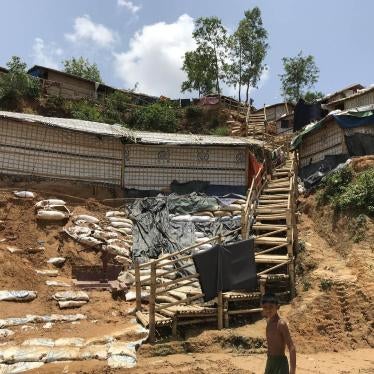Bangladesh has justifiably been praised for keeping its border open when many other wealthier countries were closing theirs. However, the camp that sprang up quickly to accommodate 700,000 Rohingya refugees fleeing an ethnic cleansing campaign by the Myanmar security forces last August and September is not safe, adequate, or sustainable. Hundreds of thousands of flimsy huts sit on steep slopes with almost no vegetation to keep the rain-soaked clay-sand mix under from eroding or suddenly sliding away.
These new arrivals joined 200,000 Rohingya refugees already in the Cox’s Bazar area who had fled previous waves of repression in Myanmar. And more keep trickling in, about 13,000 arriving so far this year because they fear for their lives. The camp is severely overcrowded with average usable space of 11 square meters per person, whereas the recommended international standard for refugee camps is 45. Under these conditions, people are at heightened risk of communicable diseases, fires, community tensions, and domestic and sexual violence.
Bangladeshi authorities insist that the camp is temporary and that the refugees will soon go home. They say this to keep pressure on Myanmar’s government to create conditions that would make possible voluntary refugee repatriation. To underscore this point, Bangladesh prohibits shelters of hard materials and cyclone-resistant buildings that might suggest permanency or a longer-term stay.
But the consequences can be life-threatening. The hurried and haphazard construction of the mega camp meant improper positioning, poor maintenance, and inadequate quantity and quality of latrines, heightening the risk of disease. The United Nations Joint Response Plan for 2018 noted that latrines had been built too close to water sources, shelters, and steep slopes, and that many latrine pits did not maintain a minimum depth of five feet. The result was that 50 percent of samples of water at its source and 89 percent of household water samples were found to be contaminated.
A 23-year-old mother of five, whose daughter was shot multiple times as they fled Myanmar, still lives in fear. “There is no safe drinking water here,” she told me. “The toilets are terrible. I want to leave this place because it is not safe. I feel fear at night. I hear gunshots some nights. I am afraid there will be landslides here because we live on a steep slope. When it rains the water comes inside our hut, so we keep making barricades to keep the hut from being flooded, but it is only being held up by sandbags.”
Donor governments should be robustly involved in supporting Bangladesh to meet the humanitarian needs of the Rohingya refugees in Bangladesh. But they aren’t. This year’s UN appeal for the Rohingya humanitarian crisis is only one-third funded, and among the most underfunded portions are for food (18 percent funded); health (17 percent), shelter (16 percent) and water, sanitation, and hygiene (14 percent).
The government’s insistence that the refugees will go home soon also means that instead of “schools,” children go to “temporary learning centers” where “facilitators,” not “teachers,” provide the rudiments of education to only about one-quarter of the school-age children. These centers provide about two hours a day of instruction geared toward pre-primary and the early primary grades. Nearly 400,000 children and youth who should be in school are not, and there is basically no education for adolescents.
The refugees I interviewed all wanted to return to Myanmar, but only when conditions allow them to return voluntarily. These include citizenship, recognition of their Rohingya identity, justice for crimes committed against them, return of homes and property, and assurances of security, peace, and respect for rights.
Today marks the one-year anniversary of Myanmar’s campaign of killings, rape, and arson that caused the exodus. It has become increasingly clear that Myanmar’s leaders, including Nobel laureate Aung San Suu Kyi, have failed to take any meaningful actions to address either recent atrocities against the Rohingya or the decades-long discrimination and repression against the population that is at the root of delays in refugee repatriation.
Bangladesh –and the rest of the world—should hold Myanmar accountable and push for the right of Rohingya refugees to return voluntarily in safety and dignity. But in the meantime, Bangladesh should acknowledge that this will not happen quickly. It should register the Rohingya who have fled Myanmar as refugees, ensure their access to adequate education, health care, and food, water and sanitation, and enable greater freedom of movement to allow refugees to engage in livelihood activities outside the camp.
Donor governments should not only step up their support for humanitarian needs in Bangladesh but also their pressure on Myanmar to adopt fundamental reforms regarding the Rohingya and take all necessary steps to reverse last year’s campaign of ethnic cleansing.










